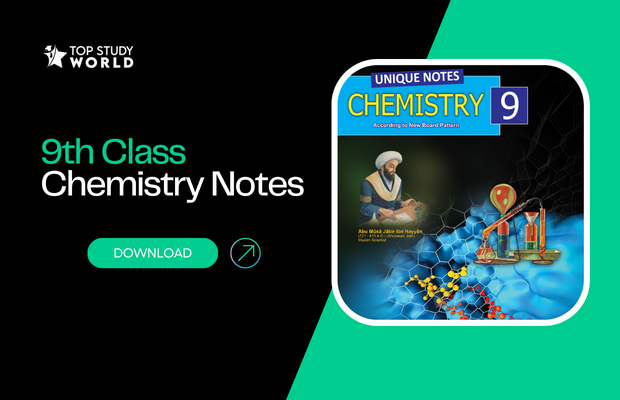The 9th Class Chemistry Notes with Solved Examples is a comprehensive guide for students studying in the Class 9 in Pakistan. These notes covers a wide range of topics, including the fundamentals of chemistry, the structure of atoms, the periodic table, and more.
9th Class Chemistry PDF Notes
Here are the notes of all 8 chapters of 9th Class Chemistry.
| Chapters | Chapters Name | Download |
|---|---|---|
| 1 | Fundamentals of Chemistry | Download PDF |
| 2 | Structure of Atoms | Download PDF |
| 3 | Periodic table and Periodicity of Properties | Download PDF |
| 4 | Structure of Molecules | Download PDF |
| 5 | Physical States of Matter | Download PDF |
| 6 | Solutions | Download PDF |
| 7 | Electrochemistry | Download PDF |
| 8 | Chemical Reactivity | Download PDF |
CHAPTER 1: FUNDAMENTALS OF CHEMISTRY

Let’s discover what the first chapter holds for the students. This particular unit will act as a guide to all the coming units. Show some interest in this one and maybe you’ll get along well with the entire Chemistry course of class 9.
See Also: 9th Class Biology Notes of All 9 Chapters in PDF
The first chapter is all about the basics of Chemistry from the definition of Chemistry to its main branches, from empirical formula to formula mass, from Chemical species to Avogadro’s number. The basic concepts of all these topics are extremely important. Make use of Youtube to learn the topics if you don’t understand them thoroughly
Download Chapter 1 : Fundamentals of Chemistry
- Size: 6.7 MB | Pages: 34 | Content: Short Questions, MCQs, Theory
CHAPTER 2: STRUCTURE OF ATOM

This chapter will upgrade the level for you now. This chapter is dedicated to the Atom. Important questions are taken from cathode rays and their characteristics. And how Proton and Neutron were discovered with the help of a discharge tube. Rutherford’s experiment is also important and its defects for a short question.
Try to clear your concepts about isotopes about hydrogen and carbon with diagrams. It may sound a bit complicated at first but it’s alright. The momentum built in your textbook for Chemistry in SSC-I is perfectly devised by expert
Download Chapter 2 : Structure of Atom
- Size: 4.8 MB | Pages: 25 | Content: Short Questions, MCQs, Theory
CHAPTER 3: PERIODIC TABLE AND PERIODICITY OF P

This chapter is truly focused on the Periodic Table and its basic understanding. The concepts explained in this chapter are essential from an exam perspective and will definitely help when you enter the F.Sc level.
Let’s look at the concepts that will be explained in this interesting chapter. Ionization energy, shielding effect, and electron affinity are critical and easy to understand. It’s a game played between the electron and the neutron.
All Subjects 9th Class Notes in One Place
The closer the electron is to the neutron, the stronger its attraction is, lesser in size, but has a high value of ionization energy and electron affinity. It’s important to grasp all the preliminary concepts regarding the periodic table because your entire knowledge about chemistry lies on this very table
Download Chapter 3 : Periodic Table and Periodicity of P
- Size: 4.4 MB | Pages: 23 | Content: Short Questions, MCQs, Theory
CHAPTER 4: STRUCTURE OF MOLECULES

This chapter is one of the most important chapters for your exams. This chapter is about how an atom mingles with each other in order to be a part of a bond either it is an ionic bond or a covalent bond.
The most interesting question is why an atom forms a chemical bond? Because it wants to be more stable as you study to be a doctor or an engineer or a biologist. Every person wants to be rich, the same goes for atoms too. Sounds pretty interesting, right
Download Chapter 4 : Structure of Molecules
- Size: 4.7 MB | Pages: 24 | Content: Short Questions, MCQs, Theory
CHAPTER 5: PHYSICAL STATES OF MATTER

In this chapter, The physical States of matter are discussed, and its laws. The most important concepts taught here are Boyle’s Law and Charles’s Law. The other critical questions are vapor pressure, evaporation, boiling point, types of solid, and allotropy.
Download Chapter 5 : Physical States of Matter
- Size: 5.33 MB | Pages: 32 | Content: Short Questions, MCQs, Theory
CHAPTER 6: SOLUTIONS

This chapter is all about solutions. Not talking about solutions to your common problems that you face in your life :). Rather it is about water solution. Saturated and supersaturated solutions are the most ideas discussed here. Then the concentration units are important for MCQs, and short questions
Download Chapter 6 : Solutions
- Size: 4.2 MB | Pages: 23 | Content: Short Questions, MCQs, Theory
CHAPTER 7: ELECTROCHEMISTRY

It is the most difficult chapter that makes most of the students puzzled. But with a positive and contemplative attitude, you will ace its content efficiently. You must have a deep understanding of oxidation and reduction reactions at this level. Make use of Youtube where you will find many Urdu videos on this topic.
Electrochemical reactions are chemical reactions in which electrons are transferred directly between substances. If a voltage source is applied to an electrolytic cell, it will decompose via an oxidation-reduction reaction. The same cell, reversed, can be used as a galvanic cell, using spontaneous redox reactions to generate electricity. The reactions take place in an electrolyte, usually liquid.
The process is called electrolysis if the reactants involve materials dissolved in a liquid (electrolyte). In chemistry and manufacturing, electrolysis separates chemically bonded elements and compounds by passing an electric current through them. When broken down into ions through electrolysis, this produces chemically pure samples. Electrochemistry is closely related to thermodynamics and electrostatics.
Many processes involve electrical potentials; for example, in photosynthesis, plants use sunlight to produce electrical potential that drives carbon fixation, while animals use food to create the electrical potential that causes muscle contraction.
Download Chapter 7 : Electrochemistry
- Size: 5.6 MB | Pages: 29 | Content: Short Questions, MCQs, Theory
CHAPTER 8: CHEMICAL REACTIVITY

This chapter is about chemical reactivity. Reactivity is the ability of an atom or molecule or even the radical to undergo a chemical reaction. That’s why this chapter is about the reactivity of metal and non-metal and much more.
The study of chemical reactions has been central to the science of chemistry since its inception. This chapter examines the main topics relevant to an understanding of the reactivity of atoms and molecules. The first section discusses various aspects of reaction dynamics, including the forces that govern reactions rates, the effects of changes in temperature and pressure on reaction rates, and the steps involved in a typical reaction.
Next, we will discuss quantum mechanics and its application to understanding the structure and spectroscopy of molecules. The subsequent section examines some aspects of thermodynamics and chemical equilibria, including relationships between the free energy change for a reaction and equilibrium constant for a response and methods for manipulating equilibrium constants. Finally, there is a discussion of some applications involving electrochemical cells and acid-base indicators.
Download Chapter 8 : Chemical Reactivity
- Size: 4.8 MB | Pages: 22 | Content: Short Questions, MCQs, Theory
We hope this compilation helps you in clearing your concepts and scoring well in the SSC part I annual exam for Chemistry.
EXPLORE OTHER TOPICS
1- Unit 9 – All Is Not Lost Notes in PDF [9th Class]
2- 10th Class Computer Science Notes For FEDERAL BOARD PDF
3- 12th Class Computer Science Notes for Federal board FBISE (New Syllabus)
4- Essay On Festivals In Pakistan For Students 200 Words

He is an SEO wizard and founder of Top Study World & Nafran, has been featured more times than a celebrity on Ahrefs, Semrush, Dawn News, Propakistani and dozens more. His superpower? Helping students ace their exams!




